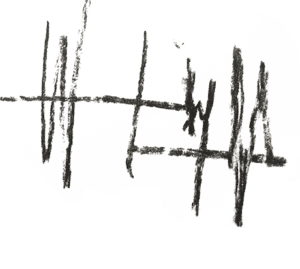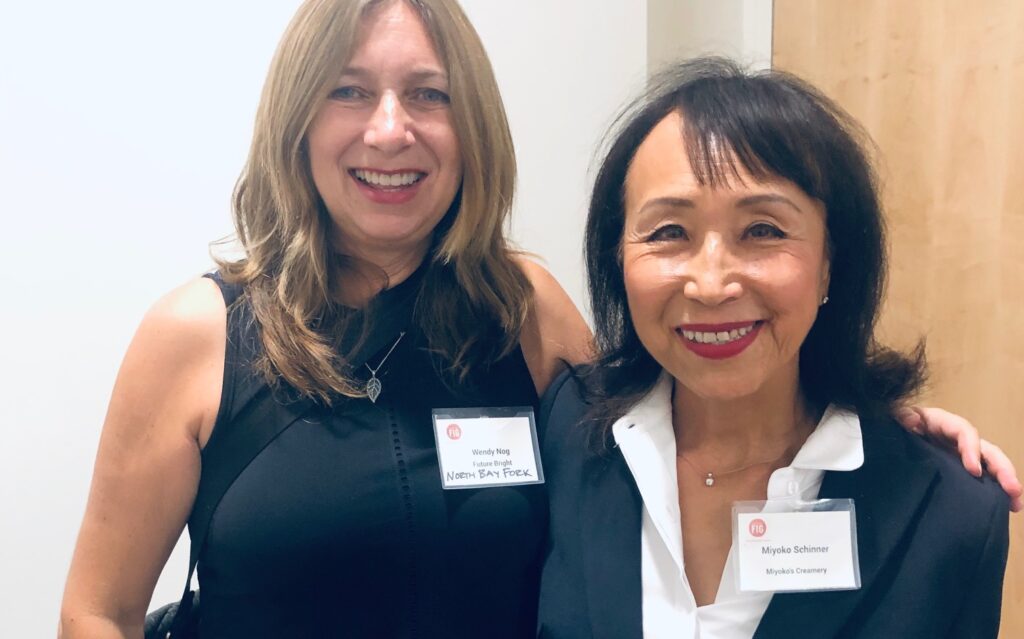Digital Marketing Campaign Architecture
Components Of A Marketing Campaign
- The target position of your customer’s journey – awareness, decision, purchase, loyalty, or advocacy.
- The topic that your content will focus on – the problem, solution, or future
- Your goal for the campaign – collect email address, sales, appointments
- The list of channels you will use – articles, email, ads, social platforms
- The tactics you will use – such as send an email that leads to a landing page, and run a retargeting ad to those who visited
A marketing campaign can incorporate many tactics such as running an ad, and an email blast, both linking to a sales page, all working together to achieve a particular goal. The challenge is in knowing what combination of tactics will work best for your business.
It is important to deeply study how humans make decisions, and what kind of information they are looking for along the decision making process. This process is commonly called “The Customer Journey” and should be integrated into your “Lead Funnel”, which is represented by a funnel shape. We have created a quick-guide to help you understand what a campaign architecture should look like, and determine what tactics will work best based on where your customers are in their journey.
The Customer Journey & Human Decision Making Process:
Step 1: Awareness- are aware of the problem or desire, may not know what the solution is.
Step 2: Consideration – have become aware of a solution and are looking at options.
Step 3: Purchase/Conversion – have made a decision, and are ready to make a purchase
Step 4: Retention – seek support from friends and and solution source that they made the right decision
Step 5: Advocacy – create a community around the decision by promoting their decision to others
The Customer Journey - Lead Funnel Diagram
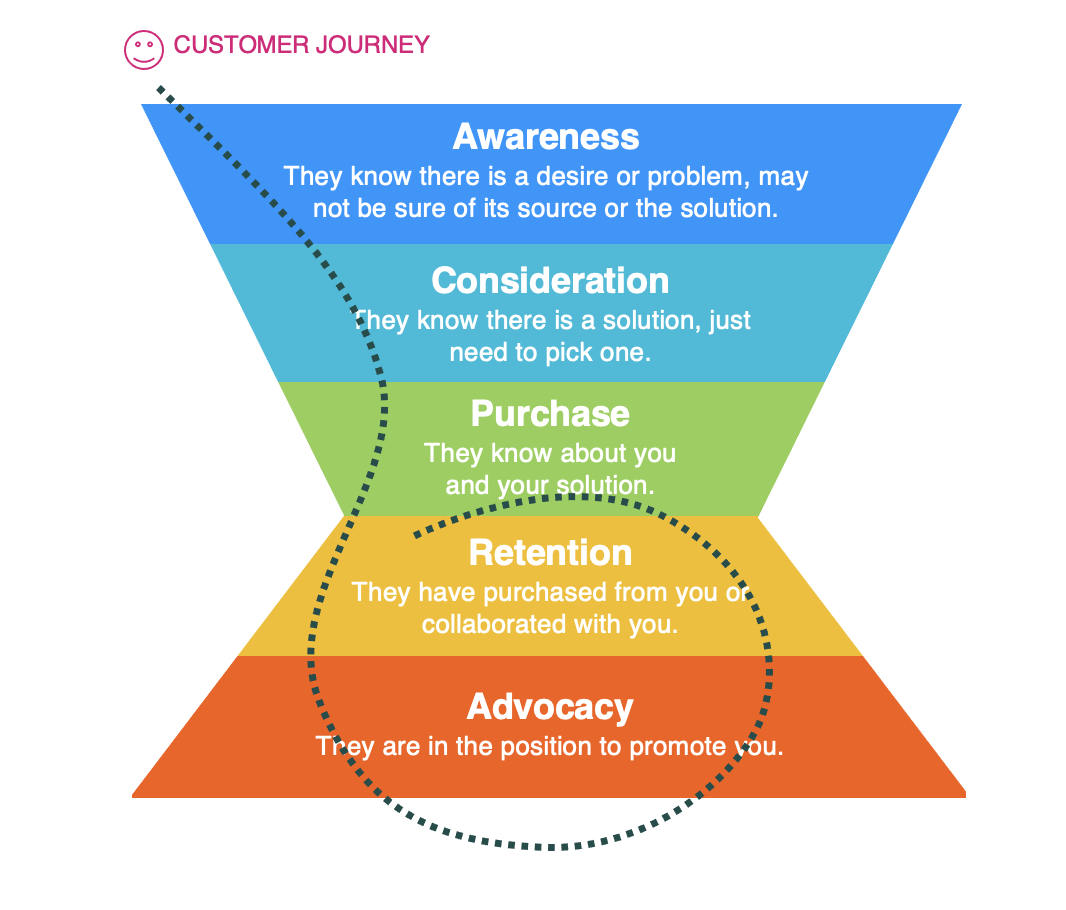

Content Topics Your Customers Are Looking For
Customers will be needing different information as they move through making a decision. Based on a quote by famed copywriter Edward Schwartz, following is a description of what information customers generally are looking for as they move to making a decision:
Content To Prepare For Your Customers
Decision: About their desire, the problem, and what it would be like if their problem was solved.
Consideration: Educate them, talk about all of the options even your competitors, show your expertise in the subject matter.
Purchase: Differentiate yourself from your competitors, talk about the details and benefits of your solution, and offer proof.
Retention: Create a relationship with your customer. Give special offers, insider information, and news.
Advocacy: Share client success stories, provide referral rewards and affiliate agreements, and opportunities to be in a community around your brand.
Content Topics By Funnel Position
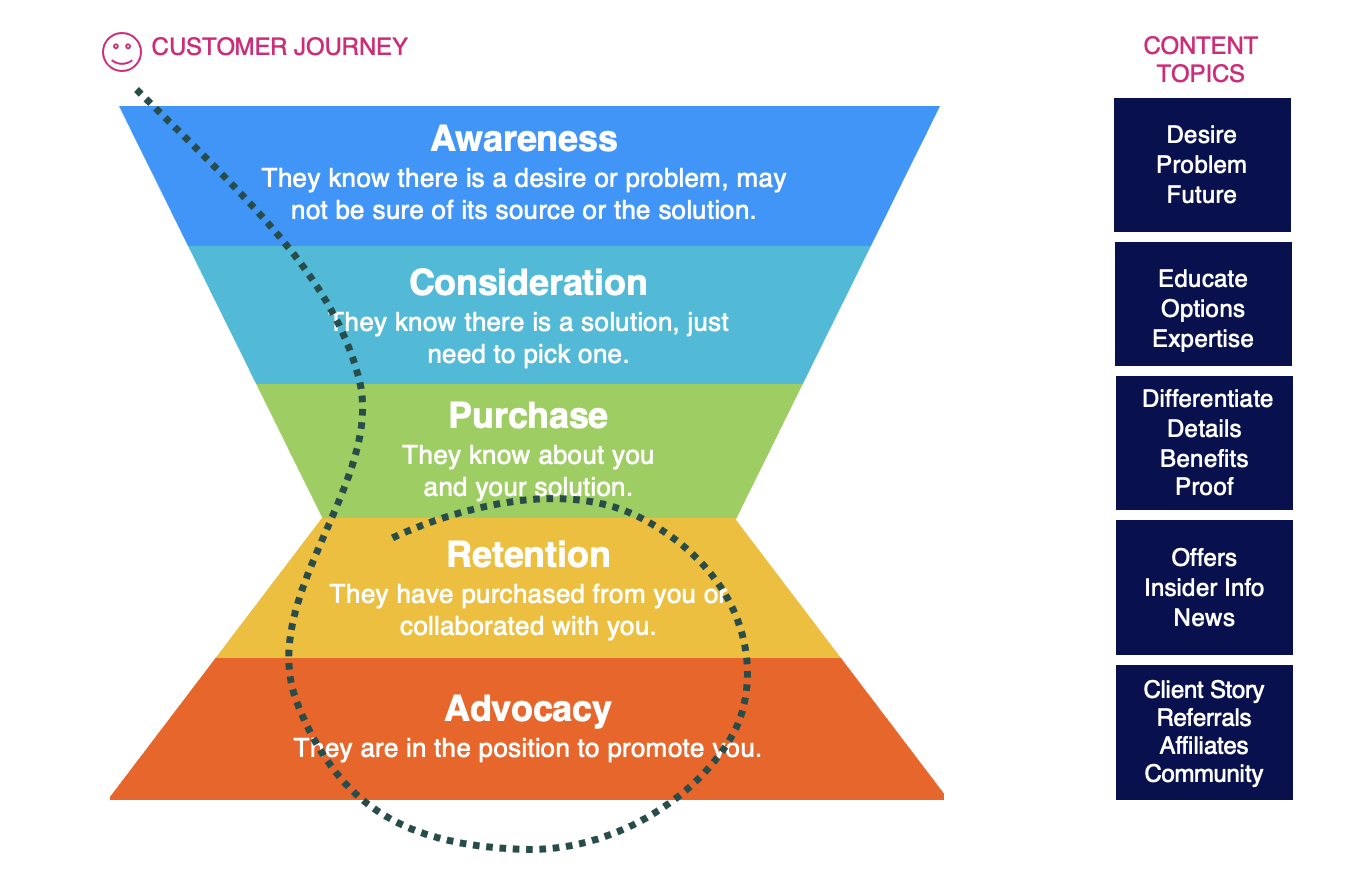




Communication Channels
Your customers will engage with your brand at different touchpoints along their journey. Ensuring that you are guiding that journey by strategically placing the right content in front of them is an important part of your digital strategy.
What channels to use and when
The below chart is the full BOLDCRAFT Framework diagram, and it shows you the channels that you will be using to engage your customer along their journey.
Awareness – get found
- Articles using appropriate keywords for searches
- Social posts using hash tags for discovery, & engaging with others
- Awareness Ads (expensive)
- Events, talks, podcast guest, etc.
- Work with partners to get the word out (influencers, etc.)
Consideration – educate them, show your expertise
- Articles showing comparison
- Social posts displaying your knowledge, expertise, skill
- Ads – they know about you, so engagement ads
Purchase – give them the differentiate, details, benefits & proof
- Landing pages
- Supporting emails
- Video
- Social Posts
- Retargeting Ads
Retention – create relationship, support their decision
- Email updates with insider info
- Video
- Social posts
- Special Events
Advocacy – create a sense of community
- Email Updates
- Social Posts
- Special Events & invitations
- Affiliate/Referral Rewards
- Special Partner Perks
Communication Channels - By Importance
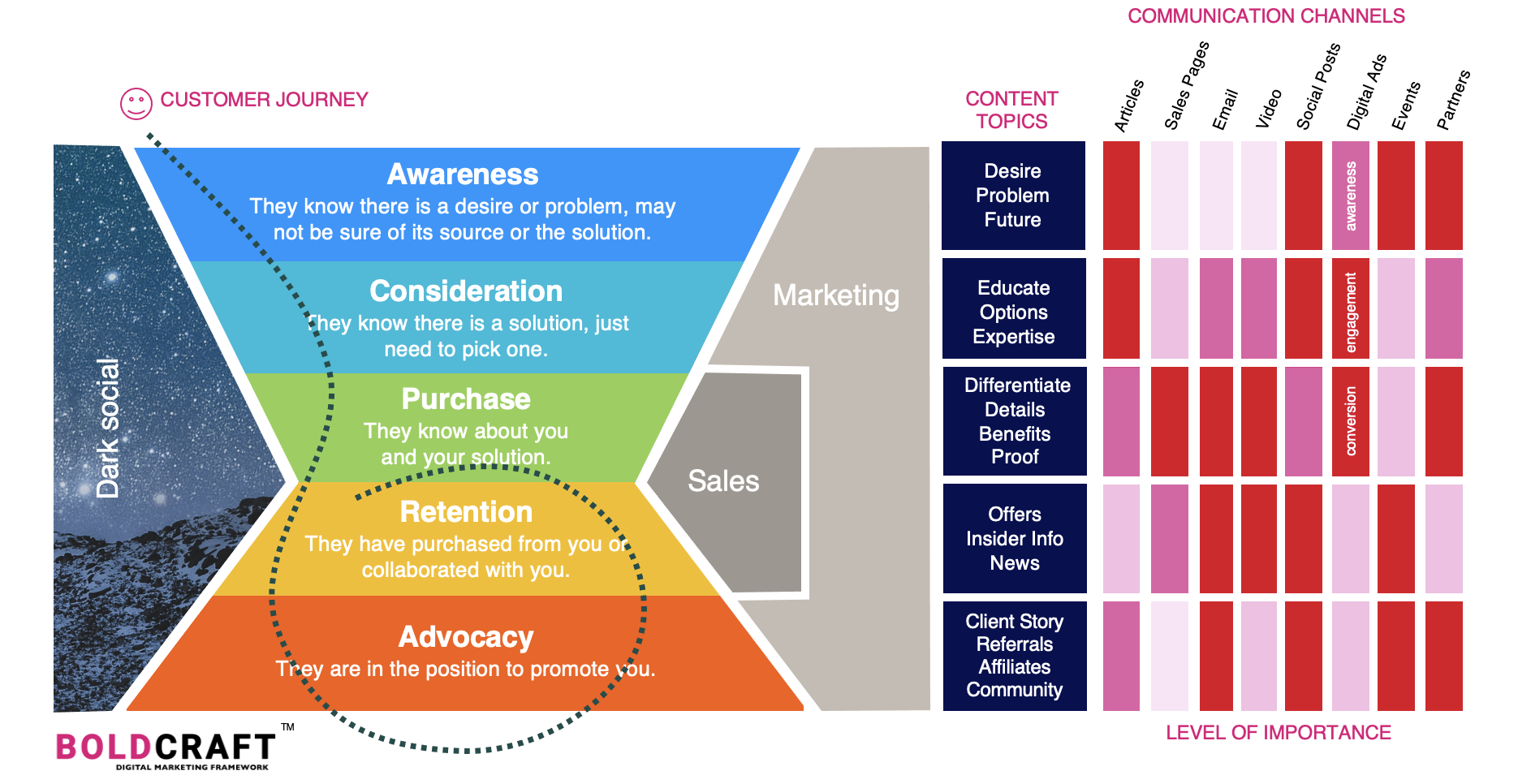

Planning Your Campaign
When you have decided to run a campaign, it is to achieve some goal. Of course ultimately the goal is to get more sales, but as we have seen by studying the human decision making process, there are many steps that must take place before they decide to buy from you. A campaign will be targeting people in one of the levels we have described in the lead funnel. You should not try to create a campaign for people in two positions, as they need completely different information.
Step 1: Identify what level in the lead funnel you want to focus on.
Step 2: Identify content keywords & hashtags relevant to that level.
Step 3: Identify which channels you will be focusing on, depending upon your resources and budget.
Step 4: Create content specific to those channels.
Step 5: Ensure that you have a plan for measuring results
Step 6: Launch Campaign – there may be A/B testing
Step 7: Follow up on all engagement
Insider Tip
Be sure that you have a Facebook Pixel or LinkedIn Pixel installed on your website. You can run retargeting ads on those platforms for anyone who has visited your website.
How should a digital marketing campaign work?
Goal:
Get your product or service into the hands of someone who needs it.
The story:
Chelsea is in a sticky situation. She has a new line of clothing that she wants to launch. She asks for help on NextDoor. You have been leaving small tips and commenting helpfully when appropriate, and as a result are known in the community as an expert on the subject. Someone recommends your business. Chelsea does a search for you on Google, and your Google My Business listing pops up so she visits your website. She has landed on your home page where you have clearly shown your professionalism and expertise, plus how she can immediately reach out to you. She suddenly gets an alert from another app, gets distracted, and leaves your site without making a purchase. Frustration!
But it’s o.k.! You made a good impression, she knows you have what she needs, AND…you have a Facebook and LinkedIn pixel installed on your website. Brilliant!
Later, as she is checking in with her friends on Facebook, your ad pops up reminding her that you have the solution to her problem. She clicks on your ad which takes her to a special page on your website designed especially for returning visitors. You welcome her back! She wonders how she had gotten distracted into leaving your site, and where the past four hours have gone! Relieved to be back where she started, and that you can solve the problem she was temporarily distracted from, she finally takes your offer! Yay!
When she makes that purchase, she is automatically added to your monthly mailing list, and receives an automated but personalized welcome email from your Customer Relationship Management tool. The email tells Chelsea the next steps, a link to a short onboarding questionnaire, and a link for her to schedule a call with you which she does right away in order to receive the bonus you promised if she schedules within 24 hours!
This all happens while you are sleeping, having gone to bed early. No more working late nights doing tasks that you suspect smart people automate, because now YOU are the smart one! Chelsea has had a seamless experience with your business, is already in love with you, and is excited to get started!


Insider Tip
After a website, the most important thing you need to have is a Google My Business profile that is completely filled out. Learn more in our article How To Create A Google My Business Profile
Digital marketing campaign architecture examples
Campaign A
OBJECTIVE: Build Profiles Of Your Target Audience
Ad campaign on Facebook and Instagram with A/B testing leading to your website and an opt-in. Testing results provide a profile of your target audience, and you can upload your opt-in list to create a “look-alike” custom audience.
Digital Tools To Use:
Facebook Ad Manager | Facebook Events Manager | Facebook Pixel | Canva Image Design | Your Website | Your CRM | Google Analytics
Campaign B
OBJECTIVE: Sales
Newsletter campaign to mailing list of new products.
Digital Tools To Use:
Newsletter (like MailChimp) | Canva Image Design | Your Website | Your CRM
Campaign C
OBJECTIVE: Repeat Customers
Offer upgrade, discount, or new services to existing clients and customers.
Digital Tools To Use:
Newsletter (like MailChimp) | Canva Image Design | Your Website | Your CRM
Campaign D
OBJECTIVE: Brand Awareness
Influencer partnership on Instagram or Facebook.
Campaign E
OBJECTIVE: Website Traffic (collected by Facebook Pixel)
Article Publishing with relevant keywords, shared and boosted on social & Google My Business.
Digital Tools To Use:
Keywoods Tool | Content Scheduler | Facebook Ad Manager | Facebook Events Manager | Facebook Pixel | Canva Image Design | Your Website | Your CRM | Google Analytics
Campaign F
OBJECTIVE: Increase Engagement On Social
Behind The Scenes photo campaign on Instagram.
Must Haves For Digital Marketing Success
Where To Start: The Absolute List
- A Website that is mobile friendly
- Google My Business Page that is completely filled out
- Facebook Page with Facebook Pixel installed on your website
- Business Listing/links to your website on other websites
- Content Marketing Strategy – keyword & goal based
- Tool for communicating with your clients
- Tool for measuring engagement
…you absolutely can have a powerful, targeted, measurable digital marketing strategy for your business. ~ Wendy Louise Nog
Marketing Articles – From The Blog
Note From Wendy
For many years I focused on the technical aspects of building digital brands, and left the marketing to others. With the onset of social media and the sudden technical maze that it has created, it became clear that I needed to step up and provide the technical grounding now needed to execute successful marketing campaigns.
My style has always been one of simplicity and empowerment. I build powerful systems that feel minimalist and easy to use. This is what I want to do for you. Whether you are a business needing marketing strategy support, or a marketing professional who needs a technical partner, I am prepared for you.
In collaboration with my own technical expertise and the many talented experts in our community, you absolutely can have a powerful, targeted, measurable digital marketing strategy for your business. Whether you are just getting started or are impacted by the pandemic and have no budget, or are in growth mode and need to go national, there is a measurable solution for you.
The first step is to reach out and tell me about your current situation, and your goals. Let’s do this!
